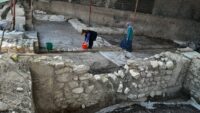 Elaborate mosaic floors from a 1st-2nd century A.D. Roman villa have been discovered in the town of Kadirli, a town in Osmaniye Province on the Mediterranean coast of southcentral Turkey. One of the central panels features the named portrait of a woman who may have been the owner of the villa. There are also floors with intricate geometric patterns, with detailed scenes from mythology and of men on horseback at hunt. These are the only mosaics depicting human figures ever found in Osmaniye Province.
Elaborate mosaic floors from a 1st-2nd century A.D. Roman villa have been discovered in the town of Kadirli, a town in Osmaniye Province on the Mediterranean coast of southcentral Turkey. One of the central panels features the named portrait of a woman who may have been the owner of the villa. There are also floors with intricate geometric patterns, with detailed scenes from mythology and of men on horseback at hunt. These are the only mosaics depicting human figures ever found in Osmaniye Province.
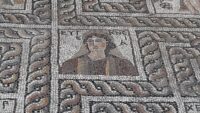 Modern-day Kadirli is believed to be located near the ancient city of Flaviopolis in what was then the imperial Roman province of Cilicia. Very little is known about the Roman town. Ptolemy notes it in passing in The Geography, but just as a dot on a map with no further information.
Modern-day Kadirli is believed to be located near the ancient city of Flaviopolis in what was then the imperial Roman province of Cilicia. Very little is known about the Roman town. Ptolemy notes it in passing in The Geography, but just as a dot on a map with no further information.
The first Roman-era mosaics were discovered at Kadirli in 2015 during a survey of the site of planned construction. Archaeologists found the remains of a public bath and a mosaic floor featuring animals — a leopard, a bull, a deer, a lion — outlined by elaborate geometric motifs. The quality of the mosaics was high, comparable to the world-famous mosaics at Zeugma, the ancient Commagene, which boasts the largest mosaic museum in the world. The site was declared a protected area and excavations have continued ever since.
Last year a figure holding a bunch of grapes in his right hand and a partridge under his left elbow was discovered. A radish in the bottom left of the panel was the first evidence of radishes being grown in the district in the 1st century. Another panel featured a man standing next to three amphorae of graduated size. All of these mosaics will be preserved in situ for exhibition.
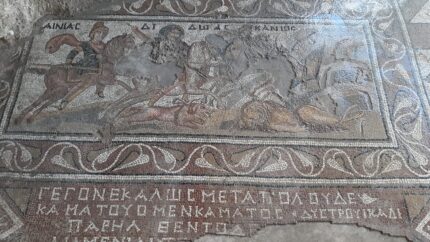
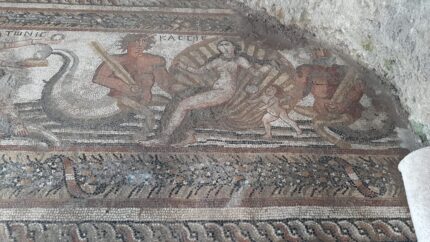
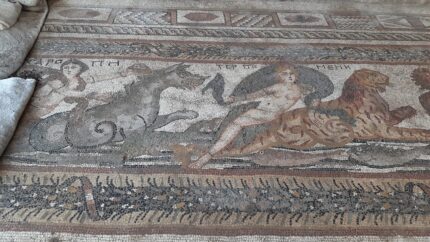
Reminds me of a Persian rug, making me wonder if such rugs were designed for people who couldn’t afford a mosaic.
🙂 interesting point of view. But as I live on southwest of Turkey town called Bodrum (halicarnassos) and Milas(Milet) swing how they still do handmade runs here, seems to me that to make rugs needed a long time as much as laying mosaics! greetings.
🙂 interesting point of view. But as I live on southwest of Turkey town called Bodrum (halicarnassos) and Milas(Milet) swing how they still do handmade runs here, seems to me that to make rugs needed a long time as much as laying mosaics! greetings.
Quite interesting how the first Roman-era mosaics there were only found in 2015! If Kadirli does have close geographical roots to Flaviopolis, it makes one wonder how many more mosaics or other relics from that time could still be found from the area. The details are very impressive, and It is amazing to be able to see all them so clearly if they date back all the way to 1st or 2nd century! :yes:
The Greek text, I have to admit, I do not quite understand, but the hunting scene seems to be from Vergil’s “Aeneis” (Bk. IV, 156-9).
Depicted are Aeneas, Dido and the boy Ascanius, plus the red lion, of course:
———–
at puer Ascanius mediis in vallibus acri
gaudet equo iamque hos cursu, iam praeterit illos,
spumantemque dari pecora inter inertia votis
optat aprum, aut fulvum descendere monte leonem.
The boy Ascanius, down in the middle of the valley,
playfully rides his hot-headed horse, outpacing several, wish that among the inert beasts there is given a churning boar that stands in his way, or a red lion descends from the mountain.
———–
A transcription of the Greek text seems to be (note that the woman, who may have been the owner of the villa, may draw parallels to queen Dido here, and a problem might be that the red lion is dead and there is no boar):
GEGONE KALOS METAPOLOUDE KAMATOU O MEN KAMATOS DYSTROUIKADI PAREL BENTOD…
Excellent comment, but your ‘red lion’ is, in fact, brown or yellow (fulvum): it can be seen on the right, moribund. The hunting dog in the mosaic is, however, red.
In the penultimate mosaic illustrated above, the scene on the right is obviously the birth of Aphrodite, but I cannot make sense of the names (‘-tonis’ and ‘Kassie’).
In the last mosaic illustrated above, we can see Kharope and Terpomene, two bacchants, appropriately riding wild animals.
The 14 ft (4.3m) square mosaic from the floor of the frigidarium in the Low Ham Roman Villa in the English county of Somerset depicts the story of Aeneas and Dido, as told by Virgil, in five panels:
First is a scene of Aeneas sailing to Carthage. The next one shows Aeneas meeting Dido, with his son Ascanius and his mother Venus. There follow scenes of the trio out hunting, of the couple embracing, and either of Venus, or else of Dido left alone after Aeneas’ departure.
upload.wikimedia.org/wikipedia/commons/5/58/Low_Ham_mosaic_5.JPG
vroma.org/images/mcmanus_images/didomosaic2.jpg